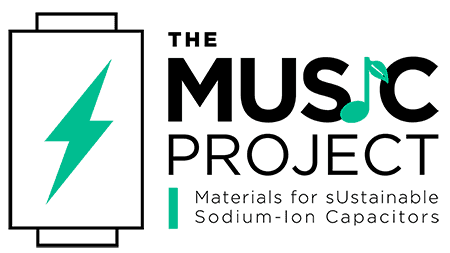The MUSIC Project, the European initiative aimed at developing new sustainable sodium-ion capacitors for renewables, industry and transport sectors. FSU is leader of Work Package 3 which focuses on the development of advanced active materials and scale-up.
Funding: European Union's Horizon Europe research and innovation programme
Project duration: 01/2023 - 12/2026
Hybrid Capacitors
Ragone Plot comparing the performance of a lithium-ion capacitor and a supercapacitor.
Picture: Khai Shin TeohBatteries and supercapacitors are the most common electrochemical energy storage devices. They have been investigated for a long time and commercialized decades ago. However, they both have their disadvantages: Batteries, while providing high energy densities, lack the ability of fast charging/discharging and display low cycle life. On the other hand, supercapacitors can be cycled very fast and often before losing their energy, but they can only store a low amount of energy to begin with. Researchers are therefore very interested in realizing a device displaying battery-like high energy- and supercapacitor-like high power-densities. This goal is approached by combining a battery-electrode with a supercapacitor-electrode in one cell resulting in a hybrid device. This hybrid device is most commonly referred to as “Metal-ion capacitor” (MIC) originating from metal-ion battery and supercapacitor. Not only is the performance of Metal-ion capacitors interesting, but also their sustainability: Often the MIC electrode materials are more abundant and environmentally friendly compared to battery materials. The first Lithium-ion capacitors have recently been commercialized (2016) and the research interest is ever growing.
Our group focuses on the electrolyte development for metal-ion capacitors. Since the two employed electrodes display two different energy storage mechanisms, the electrolyte selection is very challenging as it has to be compatible with both. In general, we try to improve the performance, safety, and environmental friendliness of the systems by using new electrolytes. Specifically, our research focuses on the most common configurations for alkali-ion capacitors (Li/Na/K-ion capacitors).
-
Publications
Hainthaler, A., Sidarthan, A., Leistenschneider, D., Balducci, A.; Enhancing the stability of sodium-ion capacitors by introducing glyoxylic-acetal based electrolyte. Journal of Power Sources Advances 2024, 30, 100158.
Teoh, K. S., Melchiorre, M. Darlami Magar, S., Hermesdorf, M., leistenschneider, D., Oschatz, M., Ruffo, F., Gómez Urbano, J. L., Balducci, A.; Fluorine-Free Lithium-Ion Capacitor with Enhanced Sustainability and Safety Based on Bio-Based ƴ-Valerolactone and Lithium Bis(Oxalato)Borate Electrolyte. Advanced Materials 2024, 36 (18), 2310056.
Kreth, F., Köps, L., Leibing, C. Darlami Magar, S., Hermesdorf, M., Schutjajew, K., Neuman, C., Leistenschneider, D., Turchanin, A., Oschatz, M., Gómez Urbano, J. L., Balducci, A.; Enabling Fluorine-Free Lithium-Ion Capacitors and Lithium-Ion Batteries for High-Temperature Applications by the Implementation of Lithium Bis(oxalato)Borate and Ethyl Isopropyl Sulfone as Electrolyte. Advanced Energy Materials 2024, 14 (13), 2303909.
-
Hainthaler, Andrea Anna PhD Student, Project: MUSIC Professorship of Applied Electrochemistry
Room R 126
Lessingstraße 14
07743 JenaImage: Anne Günther (University of Jena) -
Sidharthan, Akshaya Sidharth PhD Student, Project: MUSIC Professorship of Applied Electrochemistry
Room R 126
Lessingstraße 14
07743 JenaImage: Anne Günther (University of Jena)

